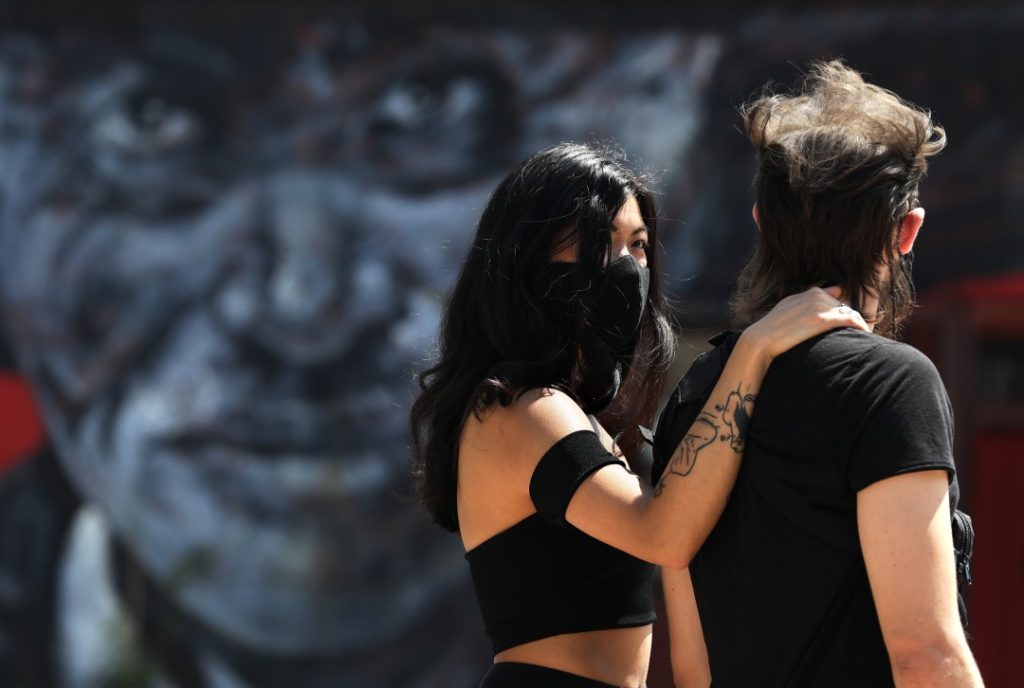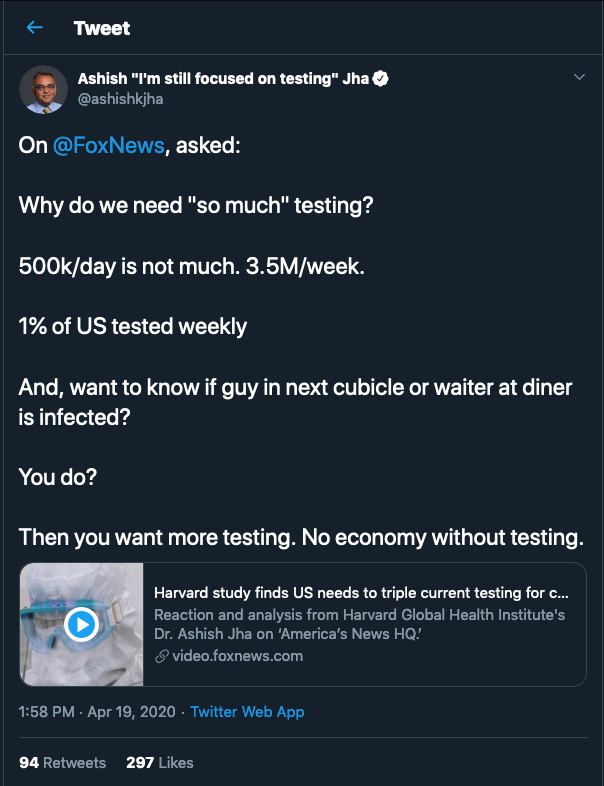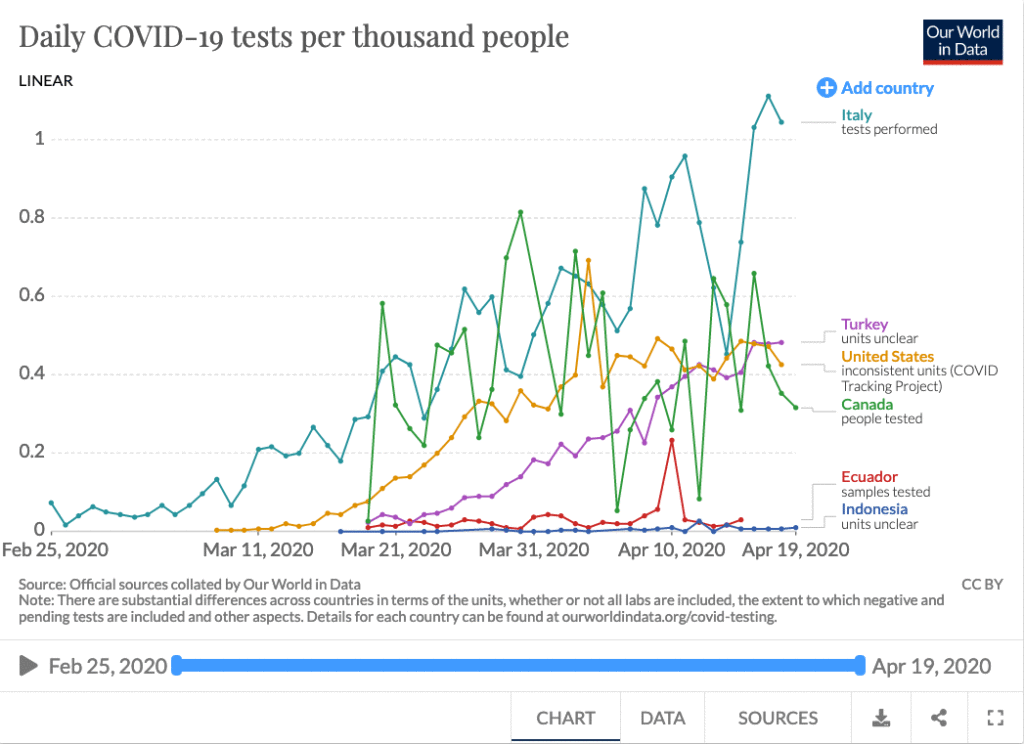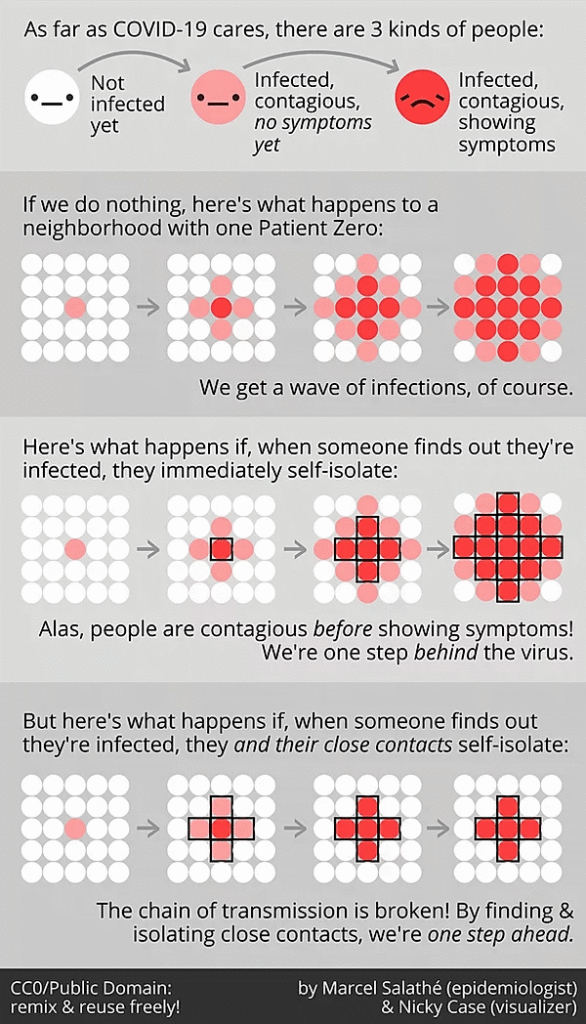I daydream about it. Especially when I bike through the park, on the uphill: I pedal hard and fix my gaze on the road ahead, imagining the release from lockdown. It won’t be the world we knew ante-Covid, but it will be less hostile, more filled with hope.
Schools are resuming, people are gathering in groups of ten; barber shops and hair salons are noisy, bustling. Everyone is wearing a face mask, but a smile is more than the upturn of the lips: without a doubt, we’ll sense a smile, the physical cues we receive when we’re near each other. And besides, laughter was never hidden anyway.

But the virus is still there. Instead of using the blunt tool of total lockdown to cope with Covid, we’ll skirt around it, nimble and alert, by recalling a simple mantra: test, trace, and isolate.
This is what the next phase will look like, according to public-health experts: tests will be given to anyone with a temperature or other slight symptoms, as well as to people who feel great. And a lot of us will feel great, especially now that we can go out, earn some money, engage our minds and skills, talk face-to-face (face mask to face mask?), maybe even get back to the gym. And, in this new regimen, if we test positive, we’ll self-isolate for fourteen days or until our symptoms abate. Importantly, the people who’ve been in our ‘virus shed distance’ will be traced and told to get a test, isolating themselves until the results come back. That’s how we’ll stop the second wave from being as devastating as the first.
“The concept is once you get down to a manageable number of cases and scale up the public health system, then you will be able to pounce on any case or cluster to proactively identify cases, identify contacts, and follow up on those contacts. And when you get those things done, you can prevent the clusters from becoming outbreaks, prevent outbreaks from becoming epidemics, and prevent the epidemics from driving us into our homes again.” —Tom Frieden, former director of the US Centers for Disease Control and Prevention
Slowly, more people will become immune, able move more freely in society. The virus will be managed with minimal strain on businesses, hospitals, and the psyche until a vaccine is developed.
This vision of the future is fed by news reports, white papers, conversations that come through my computer hour after hour as I stay at home and listen to podcasts. I’ve painted the best-case scenario, filling in details that are otherwise left vague. This scenario is based on certain assumptions:
- We have tests
- We can trace contacts
- People will self-isolate—not only if they’re Covid-positive, but also if they’re awaiting results
- Once recovered from the illness, people can reenter society with fewer restrictions
- A vaccine will be developed and distributed widely.
I’d like to test each assumption, tracing the argument as I go, isolating the logical flaws so we can address them. Because, if we don’t—if we proceed on the sheer force of will, the desire to get back to normal, to work, to renew the economy and partake of the joys of society—we’ll get slammed. And we won’t be able to recover. Not as easily, anyway. Because none of us will be as resilient a second time around.
Assumption #1: We have tests
We need tests to get out of lockdown. Full stop. And we’re nowhere near close. “This is frankly kind of still a dire situation,” says Washington state Governor Jay Inslee. Let’s put a number to the words ‘dire situation.’ What does that phrase mean?
It means the United States falls 90% short in the number of tests that need to be run each day.
Remember, the lynchpin of easing lockdown is the ability to locate people before they’re symptomatic. Otherwise we can’t stop the exponential spread of the disease, bringing us back to the emergency that led to lockdown in the first place.
Estimates range wildly, regarding the number of daily tests required, but they tend to conglomerate around 500,000 at the very low end to 2.5 million. Currently, the US is testing 145,000 people per day, according to The Atlantic’s COVID Tracking Project: i.e., one-tenth of the midrange estimate of what’s needed to safely lift lockdown.

People seem baffled by the lack of tests. But the process is complicated: chemical reagents require proper facilities to be manufactured. With the sudden surge in demand—literally billions of tests wanted worldwide—the infrastructure needed to be built, says Michael Osterholm, Director of the Center for Infectious Disease Research and Policy at the University of Minnesota. “This is not about money, it’s a question of physics. You can’t construct this kind of capacity overnight.” But it’s also a question of logistics: along with reagents, the swabs must be manufactured, purchased, distributed to areas of greatest need—and this must happen in an efficient, coordinated way.
In other words, it’s also a question of leadership.
Given the lack of reagents, Osterholm says the next phase can’t be contingent on testing. But his assessment doesn’t account for the ramped-up reagent production as well as the many new tests that are being developed, including those that use CRISPR rather than chemical reagents.
But even if tech advances come to fruition (which they haven’t yet), technology doesn’t negate the need to coordinate supply chains, or negotiate deals so states aren’t competing against one another. Osterholm is calling for a national task force on testing, as is Danielle Allen, Director of Harvard’s Safra Center for Ethics, whose white papers have mobilized scholars to generate practical, actionable responses to the crisis. Allen and Osterholm have very different views about strategies for emerging from lockdown, but they agree on the need for the national government to coordinate testing. As it is now, says Governor J.B. Pritzger of Illinois, “the federal government has really been more of a hindrance than a help.”

Assumption #2: We can trace contacts
Let’s suppose the testing gets sorted out. That’s a comfort to everyone. But you feel a slight fever one night, so you stop by a mobile testing unit: you’re positive. This will be tremendously significant to you, but it’s meaningless in terms of public health, unless we can take effective action based on the results. Which means, in large part, that we need to trace your contacts.
To carry out that task, the US requires 100,000-300,000 manual contact tracers. There are currently 2200. That’s 90% short, if we take the midrange estimate: exactly the shortfall in testing, too. At least the numbers are in synch, if we want to be macabre about it.
The authors of a report by Johns Hopkins’s Center for Health Security aren’t macabre. They seem incensed: “Public health agencies are now being asked to do something that’s never been done before at the scale required […]: find every COVID-19 case in the midst of a national epidemic with widespread community transmission already occurring and then work quickly to contain spread through intensive case and contact tracing.” The authors then note that federal funding for public-health preparedness has been cut by 28% since its height in the aftermath of SARS.
Clearly, we can’t rely on traditional methods of contact tracing. That’s okay, though. We have digital tools that can help. And we need that help, because every public-health expert says contact tracing is the key to opening our society and economy. This next phase will fail without contact tracing. That’s the reason we need so many tests. Please keep that in mind: the purpose of such testing is to facilitate contact tracing.

No one is arguing that manual contact tracing should be replaced by digital: traditional methods ensure that all populations are covered, regardless of personal smartphone ownership and regional telecommunications infrastructure. In other words, public health and equity go hand-in-hand: only manual tracing can catch the people who can’t afford the latest phones, or those in rural areas. But it’s not enough. And that’s partly because of the nature of the disease itself: unlike Ebola, SARS or HIV, this virus spreads rapidly. Writing in JAMA, two epidemiologists from Harvard and Emory explain, “to achieve effective control, contacts must be quarantined within 24 hours; SARS-CoV-2 transmission is simply too fast and manual contact-tracing too slow to curb epidemic spread.” They call for a combination of manual and “app-based” contact tracing.
Last week, I wrote about the promise of digital contact tracing. At that time, I felt strongly that a digital system could save us from extended lockdown. Whether we look to Asian governments, European non-profits, or North-American academics and entrepreneurs, we can take comfort in the human power for technological innovation to help society emerge from lockdown.
That’s what I thought when I posted the essay.
But I haven’t downloaded an app onto my phone. Have you? We need 70-80% uptake in a given locality for digital contact tracing to work. How long will that take? And how will a populace be organized around a system—educated about the risks, agreeing to give up certain privacies, assured that any such system will be dismantled when the crisis is over? We aren’t talking about this. We need to be talking about this every day, in a sustained conversation, allowing us to arrive at implicit consensus and explicit uptake.
There’s no such conversation. I hear silence. I hear the blood in my ears—my pulse getting faster, either in anger or fear: I’m not sure. But I don’t think we can take the next step, throwing open our doors and emerging from shelter. Not as the assumptions upholding the plan start to crumble.
Assumption #3: People will self-isolate if they’re Covid-positive, or awaiting test results
We should really stop here, since it’s obvious we’re not ready for the next phase of Covid. But I’d like to keep going—tracing the arguments and isolating each fundamental fault in logic—because the fault lines will open instead of our doors, to dangerous effect.
Let’s imagine that problems with testing and tracing have been resolved. You’re starting to get into the groove of going out, going to work, seeing friends—then you get a notification on your phone that you’ve come in contact with a Covid-positive person. You’re told to isolate, either for fourteen days or until you get a test. Your employer wasn’t expecting this. But everyone adjusts, ‘makes do,’ and soon you’re back at work, having received a negative test. Awesome. But you need milk. Or you need to take the subway to work. Or, god forbid, you really want to kiss your lover. So you go out. And suddenly you get a call from a manual contact tracer: you need to stay home. Again.
For how long will that continue before people start to disobey? And, if they do, how will the isolation measures be enforced?
That presumes, of course, that you can stay home in the first place. Already, we know that low-income workers—particularly those unable to telecommute—have been hit hard by the virus. Will they be able to stay home every time they get a match? Will employers allow it? If so, will they pay sick leave when you’re told to self-isolate? If not, will governments continue to bail us out, issuing checks once the country is ‘open for business’? I don’t have the answer to these questions, and I haven’t heard them discussed in my near-constant Covid newsfeed.
So I’ll set them aside to address my previous question: namely, what’s the mechanism for enforcing isolation orders. Because I have seen discussion of that issue. And what I’ve seen disturbs me.
There are really only two ways to ensure compliance with isolation orders:
- continued collective effort in the service of the public good;
- government control—either through traditional means of state power (i.e., the police) or technological means of monitoring our movement (i.e., digital surveillance).
Let’s take them one at a time.
The compliance with current shelter-in-place orders has been impressive, a sign of social cohesion—perhaps even evidence of what Rousseau calls the “general will.” That’s the concept in which we subsume private gain for the good of society, with the recognition that societal and individual good are actually the same, since we all exist within a social structure that would collapse if our government didn’t consider the wellbeing of all. Rousseau admits that his theory is only an ideal. He further acknowledges certain realities that would crush his ethereal concept. For example: deteriorating political institutions, lack of education, widespread disparities in different factions of society, and the irrational persuasive power of leaders.

It’s probably safe to assume that the ‘general will’ is not flourishing in America at the moment. Perhaps I ought to read Hobbes. He’s got some choice words, as I recall.
In the meantime, let’s look to the second enforcement option: government control.
I’ll focus my analysis on the white papers at Harvard, because this team of scholars is committed to justice and democracy. That’s the entirety of their project, as I sense it: the need to maintain the foundational principles of American democracy as it undergoes this existential challenge. Various papers explicitly argue that policies of quarantine must be guided by voluntary compliance, without police fines or arrests for violations of stay-at-home orders—punishments that would be counterproductive, given the severe financial strain on many families, the rapid spread of Covid in prisons, and the likelihood that some people can’t quarantine due to economic need or overcrowding in their home.
Enforcement should be “more of a social enforcement possibility rather than a top-down security effort.” In other words, people should be “incentivized” to isolate and quarantine. Those who can’t go to work “must be able to pay essential bills. This outcome should be achieved through a mixture of direct financial support, potentially conditioned on signals of compliance with stay-at-home orders” (emphasis added). Another benefit that might be withheld is priority access to antibody tests: “Conditioning early availability immune testing and certifications on provable compliance is a natural route, as is allowing individuals to prove certified compliance to friends and family.” The papers don’t spell out what those ‘signals’ and ‘proofs’ might be; I’m presuming they’re based on digital records of our movements, as logged on our phone, but I can’t verify that.
Before I go further, I need to emphasize: I’m highlighting the papers from Harvard because their intention is to forge a path that preserves the strength and vibrancy of American democracy. These paper are the gold standard. And yet, even here, there’s some corrosion of values. And so I highlight the fault lines in these works to say that we must tread carefully. Suggestions can get contorted in a crisis situation, especially if they aren’t given ballast by debate and dialogue.
This has gotten depressing. I’m going to embed something here that made me laugh; a friend sent it to me as I was typing that last paragraph….
Assumption #4: Once recovered from illness, people can reenter society with fewer restrictions
Isn’t that great?! I feel renewed. In fact, I feel a little hopeful again, as I did before I started writing this essay. So let’s go with that vibe, and think about the day when you recover from Covid. Maybe you never even knew you had it, but a serum test shows you’ve got antibodies. You’re home free! (I.e., no longer bound to home.) Concerts, baseball games, restaurants: go ahead, get out there, play volleyball, breathe all over everyone. You might even get an immunity certificate, a passport to freedom proposed in Britain, Germany, Italy. That’s how it’ll go down, right?
This is when we stop laughing.
Experts as diverse as the scientists who serve as editors of Nature Biomedical Engineering, the philosophers, economists, and public-health specialists who contributed to the second white paper at Harvard, to the professor of medicine who conducted the most extensive serum-testing study: all of them say that immunity should not be ‘rewarded’ with a return to pre-Covid life. “It would also create incentives for people to try to get infected. I’m not sure I favour such a policy,” says Jay Bhattacharya, the professor at Stanford professor who led the antibody study.
And besides, you might not even be immune.
I’ve sensed resistance to this idea as people clamour for antibody tests. But the fact is, we just don’t know. It’s likely that some immunity is conferred for several months, if not two or three years, as with other coronaviruses. But that hasn’t been verified, which means it can’t be the basis for policy or behaviour. And, even if you’re protected from disease, you might still transmit the virus to others. “We don’t have nearly the immunological or biological data at this point to say,” cautions Michael Mina, an epidemiologist at Harvard’s Chan School of Public Health.
We’ll get that data, in time. The answers will be found by medical science. Less certain, though, are answers to questions concerning the social sciences. If immunity is, indeed, conferred, will people continue to restrict their movements? If they’re not a threat to anyone’s health, why would they deny themselves? Do you really think bars will stay empty? Or beaches? And, if they don’t, who will stop it from happening? With what means? Hollywood has prepared us for such a scenario, albeit with different details and cheesy dialogue. History has prepared us, too.
“So the nature of War, consisteth not in actuall fighting; but in the known disposition thereto […] every man is Enemy to every man […]. In such condition, there is no place for Industry; because the fruit thereof is uncertain; and consequently no Culture of the Earth; […] no Arts; no Letters; no Society; and which is worst of all, continuall feare, and danger of violent death; And the life of man, solitary, poore, nasty, brutish, and short.” —Thomas Hobbes, Leviathan
Which leads me to the last assumption.
Assumption #5: A vaccine will be developed and distributed widely
I’m confident about the first part of that statement: a vaccine will be developed. Already, four labs have begun human trials, with more to come later this year. It’s the second part of the statement—the ‘distributed widely’ part—that causes me concern.
At this point, the international community hasn’t determined how the vaccine will be shared among the world’s population: who gets it first, who profits, who pays.
Richard Hatchett, CEO of the Coalition for Epidemic Preparedness Innovations, urges governments to act immediately to lock in a plan for “fair allocation” of the vaccine among all nations: “Right now, no government knows who the winners and losers are going to be. And no government can be certain that they’re going to have access to vaccines. Securing access […] may be an attractive deal right now. Otherwise, you’re taking your chances.”
And then there’s the roulette game within each country, determining who gets the vaccine first domestically. Health-care workers must get priority, said CDC Director Robert Redfield. But after that, he got coy, unwilling to intimate which group of citizens would receive this precious commodity first, and why. The lag between the first rollout of vaccines and the last could be months, after all: it takes time and top-tier coordination to make a vaccine. We can’t even make swabs. I shudder to think. So I won’t anymore, not right now.
The vaccine might be 18 months away; I can’t picture that far in advance. I just want to get into the sunshine and see my boyfriend before the end of spring. I want to trust others to make these decisions—to make the vaccine, the deal, the plan that keeps our society safe. But, as it turns out, democracy doesn’t work on trust. That’s the point: we’re allowed to hold our politicians to account.
Test, trace, isolate, and act
The problems I’ve identified are not insurmountable. People are working toward solutions: scientists, leaders on the local and international stage, the authors of the white papers and their colleagues around the world. There’s no need to get discouraged. But courage doesn’t come from ignorance. Instead, it comes from the ongoing struggle between knowledge and instinct: the ability to harness the animal-body, to channel its instinctual response—fear, desire, the need to protect one’s family—in the human effort toward the good. Socrates said that, not long after the Plague of Athens.
April 20, 2020